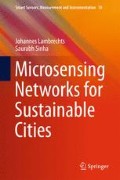Abstract
The term ubiquitous computing, also known as pervasive computing, describes a growing trend towards embedding microprocessors into everyday objects to allow communication to and from these devices, effectively rendering them smart and ideally invisible to people because of their small size and unobtrusive placement.
Access this chapter
Tax calculation will be finalised at checkout
Purchases are for personal use only
References
Agushinta, D., Kusuma, M., Junatas, B., Trihasta, D. (2011). Case Study: The Condition of Ubiquitous Computing Application in Indonesia. Ubiquitous Computing, ISBN: 978-953-307-409-2.
Barbeau, M. (2002). Mobile, Distributed, and Pervasive Computing. Handbook of Wireless Networks and Mobile Computing. 581.
Bottaro, A., Gérodolle, A., Lalanda, P. (2007). Pervasive Service Composition in the Home Network. Advanced Information Networking and Applications. IEEE, 596–603, 2007.
Brewer, E., Demmer, M., Ho, M., Honicky, R. J., Pal, J., Plauché, M., Surana, S. (2006). The Challenges of Technology Research for Developing Regions. Published by the IEEE CS and IEEE ComSoc. University of California, Berkeley.
Brown, I., Adams, A. A. (2007). The Ethical Challenges of Ubiquitous Healthcare. International Review of Information Ethics. 8(12/2007), 53–60.
Cao, L. (2010). In-Depth Behavior Understanding and Use: The Behavior Informatics Approach. Information Sciences. DOI: 10.1016/j.ins.2010.03.025.
Endler, M., Skyrme, A., Schuster, D., Springer, T. (2011). Defining Situated Social Context for Pervasive Social Computing. 2011 IEEE International Conference on Pervasive Computing and Communications Workshops (PERCOM Workshops). 519–524, 2011.
Floerkemeier, C., Lampe, M. (2004). Issues with RFID Usage in Ubiquitous Computing Applications. Pervasive Computing Lecture Notes in Computer Science. 3001, 188–193.
Forrester Research. (2006). Social Computing: How Networks Erode Institutional Power, and what to do about it. Forrester Published Report, February 13, 2006.
Garnaeva, M., Chebyshev, V., Makrushin, D., Unuchek, R., Ivanov, A. (2014). Kaspersky Security Bulletin 2014. Overall Statistics for 2014. Published 8 December 2014.
Hill, M. (2003). Distributed Computing: An Unstoppable Brute Force. SANS Institute InfoSec Reading Room.
Kurti, A., Spikol, D., Milrad, M., Svensson, M., Petterson, O. (2007). Exploring how Pervasive Computing Can Support Situated Learning. Pervasive Learning (2007). 19–26.
Magdum, N., Maldar, A., Patil, S., Tamhankar, S. (2015). A Low Cost M2 M Architecture for Intelligent Public Transport. 2015 International Conference on Pervasive Computing (ICPC). 1–5.
Miao, Z., Yuan, B. (2005). Discussion on Pervasive Computing Paradigm. 2005 IEEE Region 10 TENCON. 1–6, 2005.
Moore, J. P. T., Bagale, J. N., Kheirkhahzadeh, A. D., Komisarczuk, P. (2012). Fingerprinting Seismic Activity across an Internet of Things. 2012 5th International Conference on New Technologies, Mobility and Security. 1–6.
Moore, J. P. T., Younger, R., Abdelnour-Nocera, J., Rosunally, Y. Z., Kheirkhahzadeh, A. D., Bagale, J. N. (2015). A Sustainable Information Kiosk Driven by Sound. 2015 Sustainable Internet and ICT for Sustainability (SustainIT). 1–2.
Oluwagbemi, F., Misra, S., Omoregbe, N. (2014). Pervasive Computing in Classroom Environments and Applications. 2014 Global Summit on Computer and Information Technology (GSCIT). 1–6.
Pachouri, A., Sharma, M., Tewari, T. (2010). Green Operating System: Future Low Power Operating Systems. 2010 International Journal of Computer Applications. 1(21), 77–80.
Prandi, C., Ferretti, S., Mirri, S., Salomoni, P. (2015). Trustworthiness in Crowd-Sensed and Sourced Georeferenced Data. The 2nd International Workshop on Crowd Assisted Sensing Pervasive Systems and Communications. 402–407.
Satyanarayanan, M. (2001). Pervasive Computing: Vision and Challenges. IEEE Personal Communications. 8(4), 10–17, 2001.
Schuster, D., Rosi, A., Mamei, M., Springer, T., Endler, M., Zambonelli, F. (2012). Pervasive Social Context—Taxonomy and Survey. ACM Transactions on Intelligent Systems and Technology. 9(4), 39:1–39:21, March 2012.
Singh, S. K., Kaur, K., Aggrawal, A. (2014). Emerging Trends and Limitations in Technology and System of Ubiquitous Computing. International Journal of Advanced Research in Computer Science. 5(7), 174–178, September 2014.
Stewart, D. B. (2001). Miniature Software for Large Pervasive Computing Applications. Invited Paper at New Visions for Software Design Productivity Workshop.
Suo, Y., Miyata, N., Morikawa, H., Ishida, T., Shi, Y. (2009). Open Smart Classroom: Extensible and Scalable Learning System in Smart Space Using Web Service Technology. IEEE Transactions on Knowledge and Data Engineering. 21(6), 814–828, June 2009.
Symantec Corporation. (2014). Internet Security Threat Report 2014. Volume 19.
Tragos, E. Z., Angelakis, V., Fragkiadakis, A., Gundlegard, D., Nechifor, C. S., Oikonomou, G., Pöhls, H. C., Gavras, A. (2014). Enabling Reliable and Secure IoT-based Smart City Applications. The First International Workshop on Pervasive Systems for Smart Cities. 111–116.
Uteck, A. (2013). Reconceptualizing Spatial Privacy for the Internet of Everything.
Vicsi, K., Szaszák, G. (2010). Using Prosody to Improve Automatic Speech Recognition. Speech Communication. 52(5), 413–426, May 2010.
Xu, Y., Helal, S. (2015). Scalable Cloud-Sensor Architecture for the Internet of Things. IEEE Internet of Things Journal. PP(99), 1–14, 2015.
Zhou, J., Gilman, E., Ylianttila, M., Riekki, J. (2010). Pervasive Service Computing: Visions and Challenges. 2010 IEEE 10th International Conference on Computer and Information Technology (CIT). 1335–1339.
Zhou, J., Sun, J., Athukorala, K., Wijekoon, D., Ylianttila, M. (2011). Pervasive Social Computing: Augmenting Five Facets of Human Intelligence. Journal on Ambient Intelligent Human Computing. 1–13.
Author information
Authors and Affiliations
Corresponding author
Rights and permissions
Copyright information
© 2016 Springer International Publishing Switzerland
About this chapter
Cite this chapter
Lambrechts, J., Sinha, S. (2016). Ubiquitous Computing: Distributing Mobile Computing to Build a Global Network of Things. In: Microsensing Networks for Sustainable Cities. Smart Sensors, Measurement and Instrumentation, vol 18. Springer, Cham. https://doi.org/10.1007/978-3-319-28358-6_7
Download citation
DOI: https://doi.org/10.1007/978-3-319-28358-6_7
Published:
Publisher Name: Springer, Cham
Print ISBN: 978-3-319-28357-9
Online ISBN: 978-3-319-28358-6
eBook Packages: EngineeringEngineering (R0)

